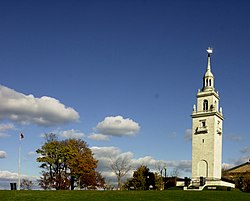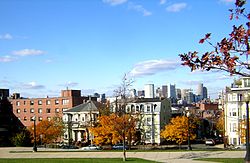Dorchester Heights
|
Dorchester Heights National Historic Site
|
|
 |
|
| Location | South Boston, Boston, Massachusetts |
|---|---|
| Coordinates | 42°19′58″N 71°2′46″W / 42.33278°N 71.04611°WCoordinates: 42°19′58″N 71°2′46″W / 42.33278°N 71.04611°W |
| Area | 5.4 acres (2.2 ha) |
| Built | 1776 |
| Architect | Peabody & Stearns |
| Architectural style | Colonial Revival, Georgian Colonial Revival |
| NRHP Reference # | 66000050 |
| Added to NRHP | October 15, 1966 |
|
Dorchester Heights Historic District
|
|
 |
|
| Location | Roughly a one block area surrounding Telegraph Hill, South Boston, Massachusetts |
|---|---|
| Area | 40 acres (16 ha) |
| Built | 1776 |
| Architectural style | Federal, Greek Revival, et al. |
| NRHP Reference # | 01001198 |
| Added to NRHP | November 01, 2001 |
Dorchester Heights is the central area of South Boston. It is the highest area in the neighborhood and commands a view of both Boston Harbor and downtown.
Dorchester is remembered in American history for an action in the American Revolutionary War known as the Fortification of Dorchester Heights. After the battles of Lexington and Concord, Revolutionary sentiment within New England reached a new high, and thousands of militiamen from the Northern colonies converged on Boston, pushing the British back within what were then relatively narrow city limits. In June 1775 British soldiers under General William Howe attacked and seized Bunker Hill, but in the process sustained many losses. Following this encounter, the Continental Congress in Philadelphia gave George Washington the title of commander-in-chief and sent him to oversee the Siege of Boston.
The stalemate in Boston lasted for months, only breaking when Colonel Henry Knox returned from Fort Ticonderoga in New York, having led a team of sleds loaded with tens of thousands of pounds of artillery (cannon) in winter from the fort across hundreds of miles to Boston. This added artillery gave Washington the firepower needed to make a decisive move. On the night of March 4, 1776, as 800 American soldiers stood guard along the river of Dorchester shores, 1,200 American soldiers occupied Dorchester Heights. They began working through the night to build structures suitable to defend against the British Army. A large portion of the artillery, pulled by oxen, was moved and installed, without being noticed by the British, at Dorchester Heights, a point of strategic importance due to its elevation and commanding view of all of Boston and Boston Harbor.
...
Wikipedia


